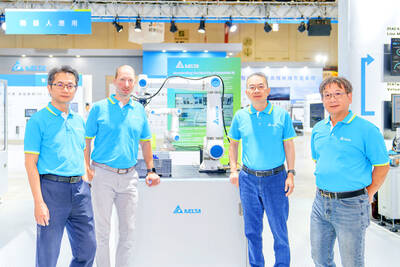The US tightened its grip on the title of world’s biggest economy last year as an irrepressible US consumer helped it pull away from China for a third straight year — at least by one measure.
US GDP increased 5.3 percent last year before adjusting for inflation, according to Bureau of Economic Analysis data released on Thursday. In comparison, China’s nominal GDP growth clocked in at 4.2 percent, the country’s National Bureau of Statistics reported two weeks ago.
The two nations’ contrasting challenges with prices in recent years help explain the widening gap between their GDP levels.

Photo: Bloomberg
The US figures are flattered by the elevated inflation rates that spurred historically aggressive Federal Reserve monetary policy tightening in 2022 and 2023. By contrast, China has been battling deflation — its so-called GDP deflator has indicated falling prices since mid-2023.
Relative sizes of economies can be measured in various ways. When adjusted for inflation, China continued to expand at a faster pace, with real GDP rising 5 percent — compared with 2.8 percent for the US.
However, nominal figures are often viewed as more relevant for things like corporate and government revenues and trade flows.
Typically, lesser-developed nations like China sustain faster economic growth rates as they catch up with their advanced rivals. China’s GDP per capita was US$12,614 in 2023, the latest year for which the World Bank has comparative data.
In the US, it was US$82,769 — showcasing the enormous catch-up potential for the world’s No. 2. However, Chinese policymakers have been struggling to contain a massive property-market slump, alongside depressed consumer confidence.
“China’s economy is in the midst of a painful but necessary transition from cement to silicon as the main driver of growth,” said Tom Orlik, the chief economist at Bloomberg Economics and a longtime China watcher. “The US continues to outperform, and in nominal terms its growth rate has been juiced by above-target inflation. The race for the world’s top GDP spot is still on. For now, the US is extending its lead.”
Consumer spending was the biggest driver of US growth last year, fueled by wage increases and employment gains. US payrolls climbed by more than 2.2 million last year, while average hourly earnings advanced 1 percent last month from a year earlier after adjusting for inflation.
That US consumption has also pulled in an increasing volume of imports, widening the politically sensitive trade deficit.
The merchandise trade deficit reached nearly US$1.1 trillion for January through November last year, and preliminary figures for last month released on Wednesday showed an unprecedented monthly deficit of US$122 billion.
China has been among the beneficiaries, with US imports from its geopolitical rival up 2.2 percent for January through November.
China’s own data showed the world’s biggest manufacturing nation accumulated a record trade surplus of some US$992 billion last year.
How this year will shape up is a major question for economists and global policymakers alike, with US President Donald Trump threatening to impose tariff hikes on US trading partners.

SETBACK: Apple’s India iPhone push has been disrupted after Foxconn recalled hundreds of Chinese engineers, amid Beijing’s attempts to curb tech transfers Apple Inc assembly partner Hon Hai Precision Industry Co (鴻海精密), also known internationally as Foxconn Technology Group (富士康科技集團), has recalled about 300 Chinese engineers from a factory in India, the latest setback for the iPhone maker’s push to rapidly expand in the country. The extraction of Chinese workers from the factory of Yuzhan Technology (India) Private Ltd, a Hon Hai component unit, in southern Tamil Nadu state, is the second such move in a few months. The company has started flying in Taiwanese engineers to replace staff leaving, people familiar with the matter said, asking not to be named, as the

The prices of gasoline and diesel at domestic fuel stations are to rise NT$0.1 and NT$0.4 per liter this week respectively, after international crude oil prices rose last week, CPC Corp, Taiwan (台灣中油) and Formosa Petrochemical Corp (台塑石化) announced yesterday. Effective today, gasoline prices at CPC and Formosa stations are to rise to NT$27.3, NT$28.8 and NT$30.8 per liter for 92, 95 and 98-octane unleaded gasoline respectively, the companies said in separate statements. The price of premium diesel is to rise to NT$26.2 per liter at CPC stations and NT$26 at Formosa pumps, they said. The announcements came after international crude oil prices

STABLE DEMAND: Delta supplies US clients in the aerospace, defense and machinery segments, and expects second-half sales to be similar to the first half Delta Electronics Inc (台達電) expects its US automation business to remain steady in the second half, with no signs of weakening client demand. With demand from US clients remaining solid, its performance in the second half is expected to be similar to that of the first half, Andy Liu (劉佳容), general manager of the company’s industrial automation business group, said on the sidelines of the Taiwan Automation Intelligence and Robot Show in Taipei on Wednesday. The company earlier reported that revenue from its automation business grew 7 percent year-on-year to NT$27.22 billion (US$889.98 million) in the first half, accounting for 11 percent

A German company is putting used electric vehicle batteries to new use by stacking them into fridge-size units that homes and businesses can use to store their excess solar and wind energy. This week, the company Voltfang — which means “catching volts” — opened its first industrial site in Aachen, Germany, near the Belgian and Dutch borders. With about 100 staff, Voltfang says it is the biggest facility of its kind in Europe in the budding sector of refurbishing lithium-ion batteries. Its CEO David Oudsandji hopes it would help Europe’s biggest economy ween itself off fossil fuels and increasingly rely on climate-friendly renewables. While